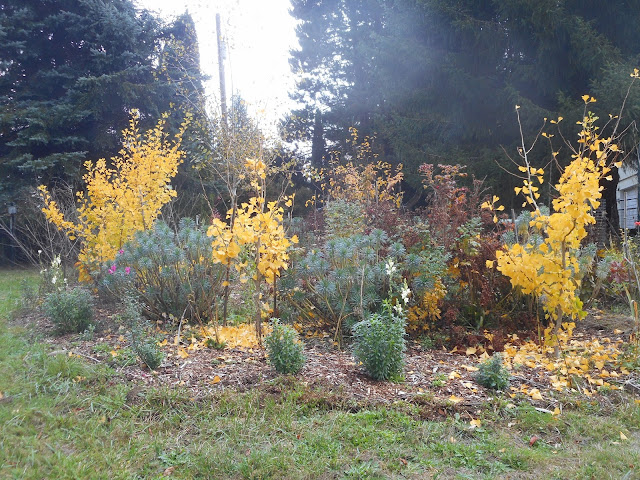These are a few of the trees I've planted. There are quite a lot more. Here I'm sticking mainly with non-fruit trees, because most of those don't reach great size and store up carbon like the big trees.
I don't understand how people can buy a 1 or 2 or 10 acre property and keep it almost entirely as lawn. I just don't get it. I may overdo the trees, but they are a heritage for future generations. As they grow, they also show a commitment to the land.
This ginkgo (yellow leaves) is from the three that I grew from seeds that my dad collected in his neighborhood in Illinois. I gave one start to him and brought the other tree here. The largest, by far, is in Vancouver. The second largest died a year from transplant. This one was the smallest. It was in a small container for too long, then planted in a bad spot, then I moved it here. It grew nicely, then the top died but it grew back nicely again. There is something about here that doesn't suit ginkgos well. Maybe it's underground animals that chew the roots. Now that this one has recovered, maybe it will be as majestic as its sibling.
One of the four Greenspire European Lindens that I planted in 2012. This is the second - largest. Doing quite well, handsome tree, no fertilizer or watering or other special treatment now. Tons of flowers for honeybees when blooming.
A close up of that ginkgo from above. I think it's about 15 feet tall now.
One of the four hybrid (European X Japanese) chestnut trees. This was a seedling, which has grafts from the others on four branches. I added those in case the main part is not productive, and to pollinate the others. Handsome tree. Chestnuts can be quite majestic regardless of their nut production. This one is about four years old.
A grafted tree, seedling from Vancouver and top from the male ginkgo tree in my old Vancouver yard, handsome tall beautiful tree. I don't know why this grafted tree has such screwy growth - not quite vertical and not quite weeping. Did I graft upside down? Will it overcome whatever it is that's making it odd? I don't know.
Another ginkgo that I grew from seeds, this one form Vancouver. Originally I grafted the other onto it, but the graft was broken. So this is 100% the Vancouver tree. It had a slow start but is beginning to take off and grow.
This is an aspen that I started from an offshoot of another aspen that I planted in 2012. I think this one is about 4 or 5 years old. Aspens grow quickly. It must be about 15 feet tall now.
Another hybrid chestnut, one of the four total. This is the smallest and took quite a while to get growing. Now it's taking off, about 2 1/2 feet of growth this year.





















































